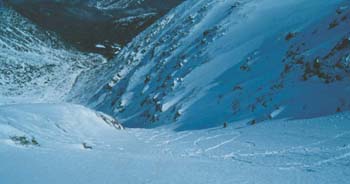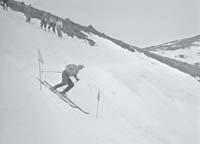 |
 |
| current issue |  |
past issues |  |
send a letter/news |  |
address update |  |
advertise |  |
about us |  |
alumni home |
Features
The Lure of Tuckerman!Page 2 of 3
To understand the ravine named after the botanist Edward Tuckerman is to understand its geography. It's as if all the elements for a screaming ski run were considered when the glaciers melted, scooping up tons of mountainside and positioning this earthly amphitheater to benefit from what many call the worst weather in the world.
 "Skiing Tuckerman gives you bragging rights," says Steve Cox '75. "It is like running the bulls."
"Skiing Tuckerman gives you bragging rights," says Steve Cox '75. "It is like running the bulls."
|
The 6,288-foot summit of Mt. Washington, as most New Hampshire residents will proudly tell you, peaks at the intersection of three major storm tracks, which results in cold (as low as minus 113 degrees Fahrenheit) and moisture (an average of 21 feet of snow annually in the upper elevations). Mt. Washington also holds the record for the highest wind—231 miles per hour—measured anywhere on the planet.
Perched less than half a mile beneath Mt. Washington's treeless summit, Tuckerman Ravine acts as a catch basin, collecting the snow blowing off the cone and upper snowfields as well as snows from the surrounding Presidential Range. Beginning in late autumn, the snow begins to fall and blow and build in earnest, burying the ravine with depths of up to 100 feet by January. While nearby Huntington Ravine receives the same assault, its pitch is steeper, forcing the snow to slide off. Through mid to late spring, Tuckerman is a bowl of uninterrupted white. As late as July, there's often enough snow left in the gullies to ski.
It's little wonder, then, that when men began exploring Mt. Washington on skis at the turn of the 20th century, Tuckerman became the favored destination. At first, skiers stuck to the gentler slope of the lower bowl. But in April 1931, two Dartmouth alums who had competed on the U.S. Olympic ski team skied over the headwall and down the bowl. Not to be outdone, a week later a group of Harvard skiers became the first to ski from the summit down over the headwall and into the bowl. All of Tuckerman, then, became fair game. New routes—Left Gully, Center Gully South, Center Gully North, Hillman's Highway, the Sluice—were discovered. Improvements were made. The narrow path through the forest to the ravine was widened to 12 feet. Then a different trail, named after John H. Sherburne Jr., who founded the Ski Club Hochgebirge in Franconia (which has housed the UNH ski team for portions of many a winter), was cut to allow skiers a separate route down to their cars. Once you've skied Sherburne to your car, says Derek Wallace '76, you'll never want to hike down again.
And then came the races, culminating with 19-year-old Toni Matt's legendary schuss from the summit to Pinkham Notch in six minutes, 29.2 seconds in the last American Inferno race. (Matt thought he'd passed the steep part when he hit Tuckerman's headwall, and, without a turn, flew over the lip at a terrifying speed.) Tuckerman was in the news. And as the decades passed and skiing became a sport for the masses and not just the elite, the path to Tuckerman became clogged with skiers as soon as Cannon and Wildcat and Cranmore closed for the season.
In the spring of 1943, when Nancy Hubbe '99G was a high school junior, she accompanied her older brother to the ravine for a week of skiing. The light snow that began on their first day became a blizzard. Sleeping in the lean-to was cold, she remembers, so she wore layers of ski clothing inside her Army surplus sleeping bag. Later Hubbe stayed dry in HoJos, the lodge at Hermit Lake, selling hot chocolate. In those early days, HoJos offered shelter and food for skiers (today it houses a forest ranger and information). When Hubbe's brother slashed his wrist as he chopped firewood, he skied down to Pinkham Notch to be tended by a doctor. Still, despite the cold, the snow and the injury, Hubbe remembers that when the weather cleared and her brother returned, they enjoyed "a beautiful week climbing up and skiing down, not always landing upright."

|
For many, tackling Tuckerman is not like childbirth; you don't forget the pain. John Poole '00 hasn't forgotten the lost foothold on the headwall and the slide all the way down the bowl on his back clutching his skis. Michael Pompian '86 hasn't forgotten his horizontal trip down when he was felled by a tumbling skier. Kilner hasn't forgotten watching a friend skid down the slope on his bottom towards a 10-foot crevasse and field of boulders before steering himself into some low brush, screaming.
But there's little comfort in others' misery for my son Luke. Both he and his 10-year-old brother were game for this summertime introduction to the slope they hope to one day ski. They have heard my Tuckerman stories. They have viewed Mt. Washington from the car, from lakeside beaches, from ski peaks. When this adventure was proposed, Luke planned to hike beyond the headwall to the summit. Jordan wasn't so sure, arguing that finishing in time for lunch in North Conway might be nice.
Yet, as we climb above treeline, roles reverse. Jordan is hot, but as he sees the top of the headwall inching closer, he senses the victory he loves so much in sports. Luke, however, rebels. His face is flushed, his strawberry-blonde hair matted with sweat. He wipes beads of water from his glasses, mumbling a litany of complaints that flows faster than the Cutler River beside us.
"I want to be hit with a fire hose."
"I wish I could fly."
And my favorite: "Where's the conveyor belt to the top?"
It's not that he doesn't like activity. He plays soccer and basketball and lacrosse, and loves to swim. But if offered a choice, he'd recline with a book. Once, a teacher assigned Luke and his classmates to write about their favorite place. He wrote about our couch. All of a sudden, for Luke, scaling Tuckerman Ravine in particular and Mt. Washington in general seems overwhelming.
"Sometimes," I say, "you have to push yourself to see what you can do." Once again, he stops, and glares. "Please stop talking, Mom," Jordan says. "You're wasting energy."
On this Friday in late August, the weather is so perfect—sunny, light wind, warm, clear enough to see almost all the way to the Atlantic Ocean—that it's hard to imagine any ill could happen in this glacial cirque. It's hard to envision the brutal weather swings that create perilous conditions for hikers and climbers and skiers. UNH ski coach Kurt Simard '91 remembers one April trip that began sunny and warm in Pinkham Notch but became snowy and bitter in the bowl. The good news: They skied eight inches of new powder. Brent Bell '89, '05G has experienced every kind of weather—sunny and warm, cold and snowy, so foggy he could barely see his ski tips. Only once, though, were the conditions so miserable that he failed to take a run.
Without the snow, it's hard to envision the avalanches that have killed six people. Because of the vast amount of snow it receives and because of its slope, Tuckerman Ravine is ripe for snow slides, which occur when an upper layer of snow fails to bond with the snow layer beneath. The trigger can be human—someone disturbing the snow, or natural—warm sun melting the top layer, high winds, an abrupt temperature change. Whatever the reason, Tuckerman's 40- to 50-degree pitch is "perfect for avalanches," says Joe Klementovich '95, who works as a photographer in North Conway and volunteers on the Mountain Rescue Service.
In the decades that Klementovich has spent hiking and skiing Tuckerman, he has avoided avalanches, but he has witnessed the aftermath. In December 2003, he hiked up to the ravine to take photos and saw where the snow had slid, filling the bottom of the bowl with "stove-sized chunks of snow." Eight hours earlier, he says, "someone would have been killed."
Page: < Prev 1 2 3 Next >Easy to print version

